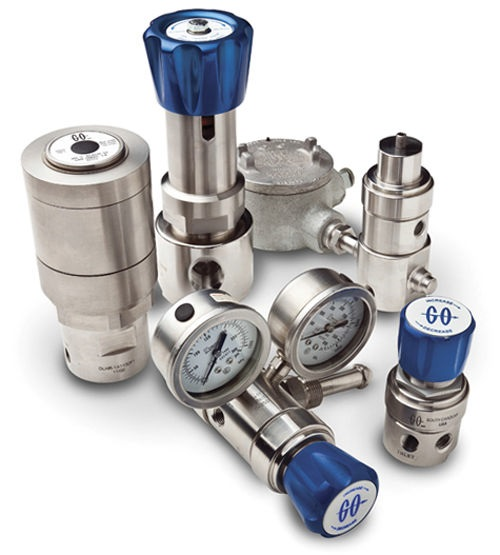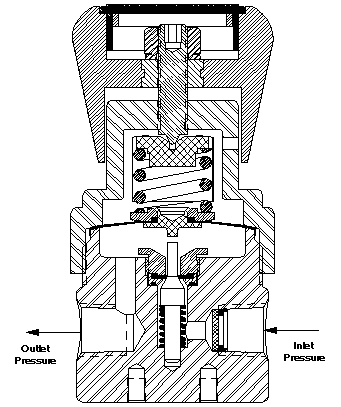When it comes to selecting pressure regulators, there is a seemingly overwhelming number of choices available on the market. But the fact is, each different type of pressure regulator has a different functionality, and therefore a different purpose in each individual application. Here at Boiswood we aim to help educate all our customers towards learning more about the different types available and how you can select the best regulator for your needs.
Types of Pressure Regulators

- Pressure Reducing – a single stage pressure regulator, designed to take a higher inlet pressure (P1) and reduce to a lower controlled outlet pressure (P2).
- Back Pressure – a back pressure regulator (or “overflow” regulator), designed to maintain a constant inlet pressure (P1), offering end users a controlled and stable line pressure.
- Cylinder Pressure – a dual stage pressure regulator, designed to take a higher inlet pressure (P1) and reduce to a lower controlled outlet pressure (P2). These are often installed on gas cylinders/bottles to provide a higher level of control accuracy as the cylinder depletes.
- Vaporising – either electrically heated or steam heated pressure regulators, designed with either pressure reducing (single stage), back pressure or dual stage mechanical operation. Vaporising regulators are used to heat the media as it passes through the wetted flow path, often situated upstream prior to sampling systems or analysers.
- Speciality Regulators – regulators utilising any of the above-mentioned principles, except designed for different applications including miniature/compact versions for small space claims, dome-loaded for pneumatic pilot air operation, high pressure design for up 10,000 PSIG control, high flow design for up to 3.00 Cv, high temperature for up to +537°C, crossover manifolds for automatic changeover of cylinder bottles and more.
Function of a Pressure Regulator

Taking our popular PR1 Series single stage pressure reducing regulator as the example, when the media flows into the unit via the inlet port, it is held bubble-tight underneath the poppet in the seat area, as shown by the red area in the animation. The user can then wind down on the hand knob, which pushes the diaphragm down onto the poppet (manually actuating the diaphragm), to achieve the controlled release of outlet pressure, as shown by the blue area in the animation.
How to Size a Pressure Regulator
There are multiple different technical factors to consider when selecting a suitable pressure regulator. The main operating parameters needed to correctly size a unit are as follows:
- Inlet Pressure (P1 or Upstream Pressure usually in BAR or PSI)
- Outlet/Control Pressure (P2 or Downstream Pressure usually in BAR or PSI)
- Flow Rate (Q usually in m³/h or SCFM)
- Media Temperature (T usually in °C or °F)
- Media (To calculate the Specific Gravity or Molecular Weight/Density)
These 5 factors are required to correctly calculate a CV or KV value for the regulator. It is imperative that the correct CV is selected for a pressure regulator to ensure that the desired flow-through the unit is met.
By providing us with these values, we can utilise our extensive calculation tools to size and suggest on a suitable pressure regulator. You can also view our more detailed regulator sizing guide by clicking here.
Some of the other important factors to consider when selecting a pressure regulator are as follows:
- Materials – what construction materials should be used? This includes both the body material and any other wetted elastomer materials (such as the seat). Aside from the standard 316L Stainless Steel or Brass construction materials, you may need to consider both the flowing media and installation environment. If the unit is going to be used with particularly aggressive media (such as HCL) or installed in harsh environments (where sea water could splash onto it), it would be worth considering Exotic Alloy materials such as Monel® or Hastelloy® to ensure longevity of the regulator.
- Connections – what is the line size the unit needs to fit on? Typically, most of our instrumentation sized regulators detailed in this blog are available between 1/8” and 3/4” NPT port sizes. For larger pipe sizes, you would need to consider our range of self-acting control valves that range from sizes 1/2” up to 6” in Nominal Diameter (DN), and are available with threaded, flanged, weld and other special connections.
- Special Considerations – are there any special conditions that may affect the choice of unit? Will the unit be installed in harsh environments? Does the unit need to be tamper-proof or installed on a panel? Are there any specific cleaning or testing standards needed? Is there a chance the unit will see pressure spikes or fluctuating pressures? The more detail we have, the better we can advise you.
Pressure Regulator Applications
Pressure Regulators are used in an enormous selection of applications and industries, from industrial to analytical/high-tech to UHP environments. Some of the typical applications we work with are as follows:
- Analytical Instrumentation – Controlling pressure to feed gas analysers, coating application systems.
- Gas and Liquid Sampling – Sample conditioning systems, calibration gas systems.
- Air Compressors – Breathing air filling system, periphery clean dry air pressure control.
- Gas Cylinders – Specialty gas cylinder pressure control.
- Research Labs – Laboratory fluid pressure control, gas blanketing systems, pilot plant systems.
- Let Down Stations – Pressure let down stations for CO2, N2, H2, CH4, O2, He and more.
Pressure Regulator Supplier in the UK
Our selection of pressure regulators offers our customers a variety of options and configurations to meet almost any application. To explore our full range of pressure regulators in more detail, please visit our category page here.
For technical support on selecting the right pressure regulators for your application, get in touch with our experienced engineers here.
Looking for a quick delivery? To view our selection of pressure regulators in-stock and readily available for next-day delivery, click here to see our intuitive part number configuration.
